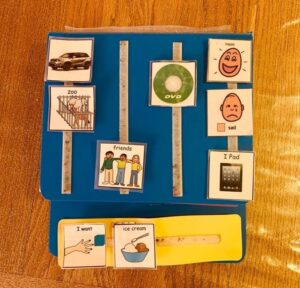
Clear communication is the key
Communication is one of the most important ways in which we exert control. Many people with learning disabilities have difficulties with communication and these may contribute to challenging behaviour.

Robert Steeples (a Care Manager) and Amy Steeples (a Speech and Language Therapist) tell us about communicating with their sister, Claire (who now lives in her own home and has severe learning disabilities). This article is from our Summer 2021 Challenge newsletter.
We communicate all the time for various reasons because human beings are programmed to seek out others and make our needs known, to share ideas, and to share problems and to hopefully find solutions. It is a fundamental and basic need in our lives.
Augmentative and Alternative Communication (AAC) strategies are additional ways of supporting someone to communicate. One particular AAC strategy has completely changed the quality of life for our sister. The tool is known as Picture Exchange Communication System (PECS); it is a communication tool which uses pictures and symbols to help an individual initiate communication and conversation. It must be implemented in a controlled, personal-centred and planned way to ensure its success.

PECS originated from America and was started for pre-school children who had a diagnosis of autism, helping them to begin communicating what they wanted and needed. It is now used worldwide and each person using this system has a personalised folder of images that are useful and relevant to them. To communicate, they select an image and hand this to the communication partner to request that item, for example they may find and exchange an image of a glass of juice to request a drink. As the individual becomes confident using the system, this can be built up to create sentences, to request more complicated items or even to comment and communicate thoughts and ideas about a subject such as on a walk – ‘I see a bird’.
Our sister Claire has a severe learning disability. As Claire got older and moved into adult residential settings, the care and support she had previously received changed. One-to-one support was almost non-existent and previously nurtured skills were lost and forgotten. Claire became isolated, as support and encouragement stopped. Her anxieties increased hugely and so did her challenging behaviour. She had no control or choice over her day, had no way to communicate and no supports were put in place to help her understand what was happening. Staff regularly reported she was too old to learn new skills and was seemingly written off. This escalated over the years that she spent in adult social care and led to her pulling out half her hair. She went on to develop strong challenging behaviours that we still see at times today.
When she was 30 the family made the decision that enough was enough and they bought Claire a small house and began setting up a caring environment around her that was person centred to meet all her needs, one of the biggest being her communication.
Claire was introduced to PECS by Robert and he created a folder of symbols to include all her favourite things and most treasured items. Slowly he built up her knowledge of the images and repeatedly they practised exchanging for items until Claire realised the meaning and benefits of the exchanges. This changed her life. All of a sudden, she had the beginnings of control and had a voice that was being listened to. Her challenging behaviour slowly reduced, her confidence grew and finally, so did her hair. In her 30s, Claire was able to learn a new way to communicate and create a new life because she had the right help and support around herself. Her motivation and desire to communicate was always there, it just needed to be unlocked.

Since then, Claire and her family have spent time campaigning for personalised care and the rights of adults with learning disabilities, particularly for support around communication. In 2015 they were invited to London to meet with Sir Simon Stevens, head of the NHS to talk about personalisation in the adult care world. Claire communicated with him using her PECS and showed off her newly found voice.
Now, at age 43, Claire’s PECS book is central to her life. Throughout the day she will select images of activities she would like to do, items she has lost, to request a snack or drink or even to ask for bath and bedtime. She knows that when she uses her symbols, she can communicate what she needs and that this will be listened to and get a response. At times she can’t always have what she has requested such as numerous ice creams! But that begins a conversation and she can be helped to understand why that can’t happen or build it into a schedule for later in the day. This has become even more prominent recently with the arrival of Covid-19. Routines stopped overnight and many of the activities Claire loves have been closed. It has been a challenge, but Claire has been so resilient and has adapted to these changes, finding new interests in crafting, baking, dog walking and a huge love of virtual sessions!
Claire’s life has changed vastly and all for the better. She now has a life, not just an existence, and most importantly, she has the power of communication.
Robert and Amy Steeples
This article has been adapted from an article first published for Carousel, the Diplomatic Service Families Association magazine (with their kind permission). Read the complete article by clicking on the image.
Read more about Claire’s story on the Your Stories part of our website

Communication is one of the most important ways in which we exert control. Many people with learning disabilities have difficulties with communication and these may contribute to challenging behaviour.

You can find past editions of our Challenge Newsletter from the last five years on the ‘news’ section of our website. We produce around three editions every year.

The family of Claire Steeples, 43, tell her story, where determination and the use of a personal budget to buy care, have transformed Claire's life